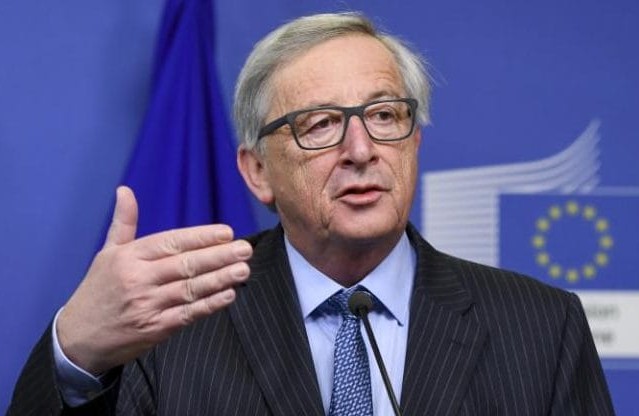Jean-Claude Juncker, the president of the European Commission, has drawn up a White Paper setting out five options for the future of Europe after Britain quits the EU in 2019
Jean-Claude Juncker, the president of the European Commission, has drawn up a White Paper setting out five options for the future of Europe after Britain quits the EU in 2019. The plan sets out five “pathways to unity” for the 27 member states who will remain in Europe after Britain leaves in 2019. The proposals have already met opposition from recalcitrant eastern EU states, led by Poland and Hungary, who fear that they will be marginalised by a new drive to revitalise Europe's Franco-German federalist core. Mr Juncker’s blueprint will be the basis for talks at a summit in Rome on March 25, to mark the 60th anniversary of the bloc's founding treaty. This will start a nine-month debate that will culminate at a December European Council meeting, after the French and German elections. The five options are as follows: In this scenario the EU27 "sticks to its course" but, Mr Juncker notes, the speed of EU decision-making "depends on overcoming differences of views in order to deliver on collective long-term priorities". In other words, the decision-making remains unwieldy, as at present. Mr Juncker says that by 2025 this strategy will deliver only "incremental progress" on jobs, economy and the Euro, while on defence, EU co-operation is "deepened in terms of research, industry and joint procurement" allowing member states to "pool some military capabilities and to enhance financial solidarity for EU missions abroad". Pros and cons: the "unity of the 27 is preserved" but will still require a "collective resolve" to deliver on key issues, a resolve that has been transparently lacking of late, say on immigration and back-stopping the Euro. The risk, adds Mr Juncker is that in the absence of such unity, Europe may fail to "close the gap between promises on paper and citizens’ expectations". The EU gives up on trying to resolve divisive issues such as "migration, security or defence" and co-operation on key issues becomes more bilateral than EU based. Radically, the EU also shrinks the regulatory burden by dropping two pieces of legislation for every one it passes. By 2025 this will mean the functioning of the Single Market becomes the "raison d'etre" of the EU, strengthening the free movement of goods and capital, but making it tougher in other areas, like free movement of people. Pros and cons: The EU's "re-centred priorities" focusing on the core single market issue, makes decision-making "simpler" but it also restricts the ability of the EU to deliver to its citizens. "This may widen the gap between expectations and delivery at all levels." Create one or more "coalitions of the willing" to drive forward specific areas, such as the defence, internal security, taxation or social policy. Other member states, outside those coalitions, "retain the possibility" of doing more over time. By 2025 this could create a more effective EU defence capability with "enhanced military readiness for joint missions abroad", as well as deepening intelligence co-operation. Eurozone countries integrate further on taxation and social matters. Pros and cons: Mr Juncker says this approach will preserve EU unity by allowing some member states to opt out, but will naturally see EU citizens' rights "start to vary depending on whether they live in a country that has decided to "do more". This creates a two-speed Europe as the gap between expectations and delivery "starts to close" among those countries deciding to integrate more deeply. The EU decides to narrow down its priority list, and do what it does more efficiently. As a result the EU is able to "act much quicker and more decisively". Mr Juncker gives the example of the recent VW diesel emission standards and says this version of the EU would have the "powers and tools" to protect EU consumers in a "direct and visible" manner. By 2025 this means deepening the single market and focusing on R&D and EU-wide projects to support "digitisation and decarbonisation" - ie green projects and digital integration. It would also step back from less core areas, such as employment and social policy and public health. Pros and cons: Where the EU does act, it would be more concrete and visible. On the downside, Europe may not agree where to start since, as Mr Juncker concedes, the EU27 has "real difficulty in agreeing which areas it should prioritise or where it should do less." Accepting that the current half-cocked EU doesn't work and that retreating to a more bilateral model will not meet the globalised challenges of the modern era, the EU 27 "decide to share more power, resources and decision-making across the board". In this scenario - unlikely given all the caveats above about the lack of unity in the current EU - decision-making deepens and speeds up and decision are agreed faster at EU level and are "rapidly enforced". By 2025 this means that internationally "Europe speaks and acts as one in trade and is represented by one seat in most international fora", and a European defence union is created in co-operation with Nato, with the EU becoming a global leader on aid and trade. The Eurozone has much greater co-operation on "fiscal, social and taxation matters". Pros and cons:The EU moves much more quickly and powerfully and citizens derive their rights much more from EU than from national law. On the downside, Mr Juncker acknowledges the risk that "alienating parts of society which feel that the EU lacks legitimacy or has taken too much power away from national authorities."Scenario 1. Carrying on
Scenario 2. Nothing but the single market
Scenario 3. Those who want more, do more
Scenario 4: Doing less more efficiently
Scenario 5: Doing much more together
In full: White Paper on the Future of Europe






